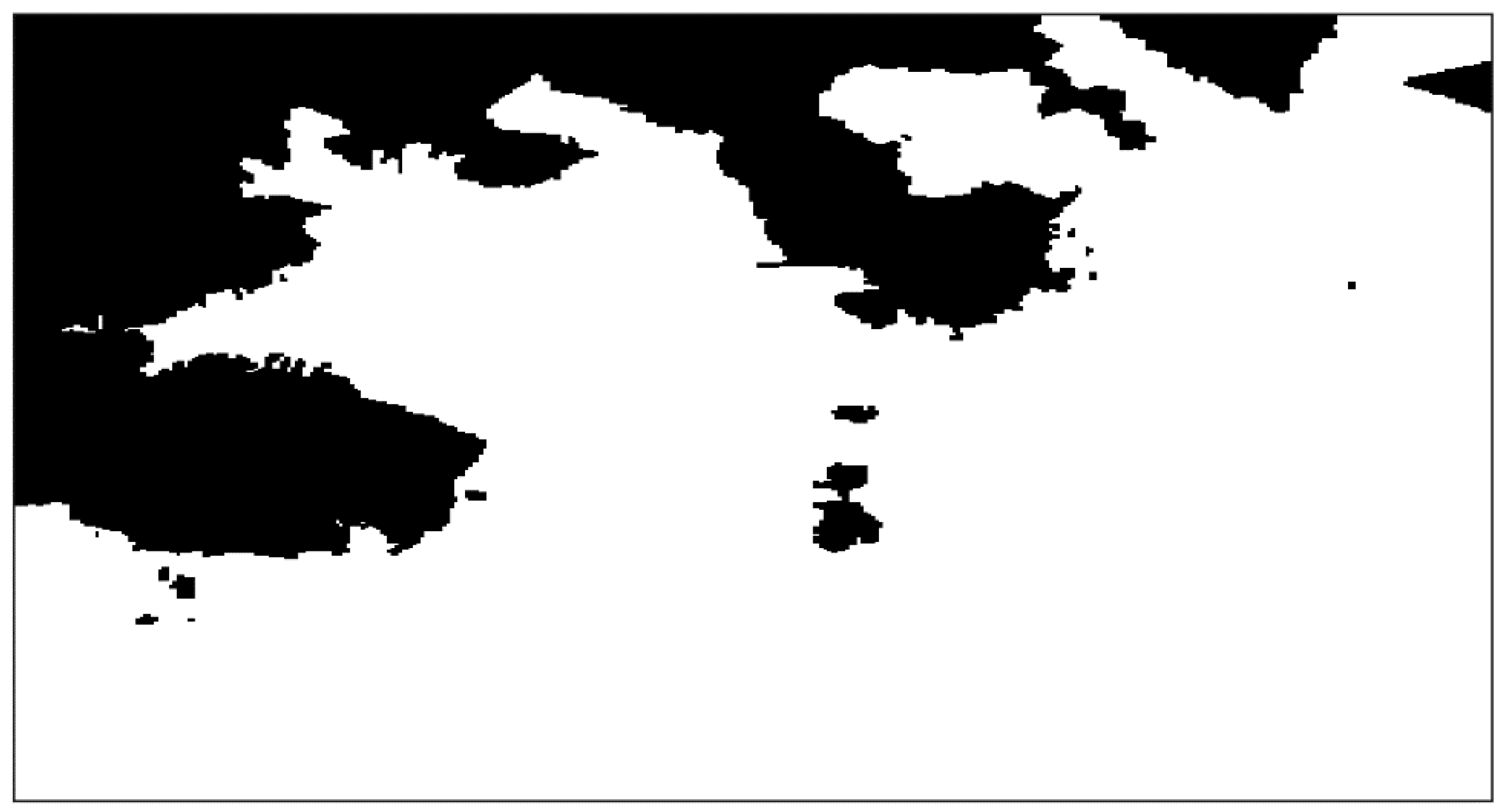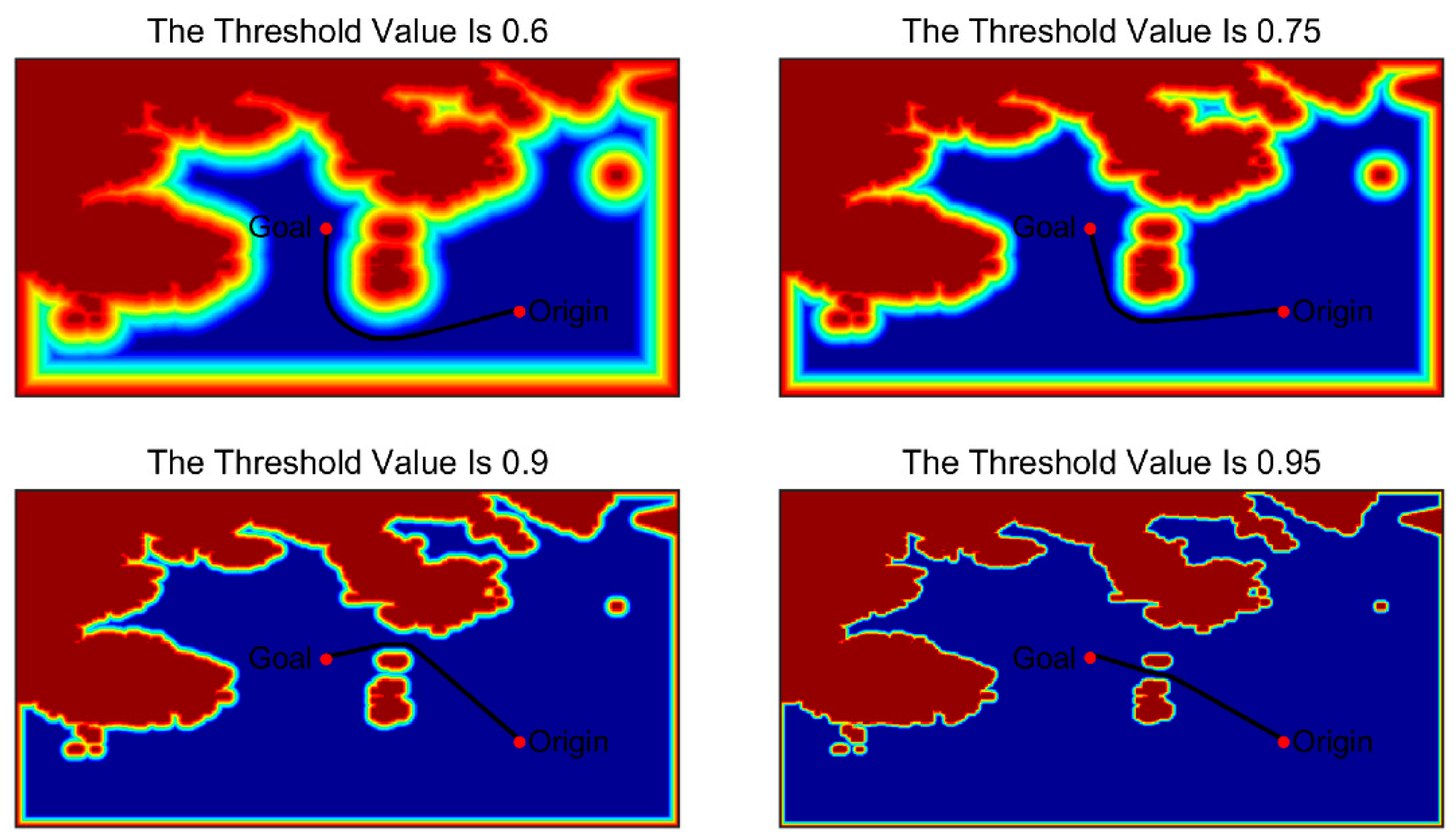A Locking Sweeping Method Based Path Planning for Unmanned Surface Vehicles in Dynamic Maritime Environments
Abstract
:1. Introduction
1.1. Literature Review
1.2. Discussions on USVs Path Planning
2. Fundamental Methodologies
2.1. Fast Sweeping Method (FSM)
| Algorithm 1. Fast Sweeping Method Algorithm. |
| Input: potential field (), initial point (), , grid map(), Initialization: 1. 2. Sweeping: 3. stop←False 4. while stop ≠ True do 5. for k = 1:4 do 6. ←FSMComputeT(, , , ) 7. end for 8. Ture←JudgeConvergence () 9. stop←Ture 10. end while 11. return |
2.2. Locking Sweeping Method (LSM)
- Step 1: Set initial arrival time at all points to infinity; set arrival time to 0 for sources
- Step 2: Set the obstacle area node with the locked state and other nodes with the unlocked state
- Step 3: Perform the LSM algorithm. If a point is locked, proceed to the next one without computing anything. If a point is unlocked, compute the arrival time at it using Equation (4)
- Step 4: Determine whether the value of the node converges, if so, change the locking state of the node to locking, otherwise do nothing
- Step 5: When all nodes in the interface are locked, stop the iteration
| Algorithm 2. Locking Sweeping Method Algorithm. |
| Input: potential field (), initial point (), locking map(), grid map(), Initialization: 1. 2. 3. 4. if belongs to the obstacle area then 5. 6. end if Sweeping: 7. stop←False 8. while stop ≠ True do 9. for k = 1:4 do 10. ←LSMComputeT (, , , ) 11. if the value of converges then 12. ←1 13. end if 14. end for 15. if do 16. stop←True 17. end if 18. end while 19. return |
3. Planning Space Representation Based on LSM
3.1. Static Obstacles Representation
3.2. Dynamic Obstacles Representation
4. USV Path Planning Algorithm
- Step 1: First, the task environment map is transferred to a grid map, and the LSM is used to generate the static environment field, as shown in Figure 13a. During the entire planning process, the static environment remains unchanged, and the generated field matrix can be recorded as and stored for later simulation.
- Step 2: On the basis of , the static full potential field was obtained using LSM, with the goal of the task as the initial point of sweeping, as shown in Figure 13b. The generated field matrix is recorded as .
- Step 3: Within each control period t, according to the instantaneous position and speed of the dynamic obstacle, LSM was used to model the dynamic target, and the results were normalized to obtain the dynamic obstacle field map, as shown in Figure 14. The generated map matrix is recorded as .
- Step 4: The final environmental potential field matrix is obtained by superposing and , as shown in Figure 15.
- Step 5: According to the instantaneous position and speed of a USV, the gradient descent method was applied in to obtain the path planning point, and the USV sailed toward the planning point.
- Step 6: If the USV reaches the mission goal, then the cycle ends; otherwise, go back to Step 3.
5. Simulation Results and Discussions
5.1. Comparison Results of FMM, FSM, and LSM
5.2. Simulation Results of USVs Path Planning in Practical Environments
5.2.1. Global Static Planning Simulation
5.2.2. Local Dynamic Programming Simulation
5.2.3. Simulation of Tasks in a Dynamic Environment with Multiple Moving Ships
6. Conclusions and Future Work
Author Contributions
Funding
Acknowledgments
Conflicts of Interest
References
- Manley, J.E. Unmanned Surface Vessels 15 Years of Development. In Proceedings of the Oceans 2008 MTS/IEEE Quebec Conference and Exhibition, Quebec City, QC, Canada, 15–18 September 2008; pp. 1–4. [Google Scholar]
- Zhu, W.; Zhang, L. Development of Unmanned Surface Vehicle. Mar. Technol. 2017, 1–6. [Google Scholar]
- Mitchell, J.S.B. Shortest paths among obstacles in the plane. In Proceedings of the Ninth Annual Symposium on Computational Geometry, San Diego, CA, USA, 19–21 May 1993; pp. 308–317. [Google Scholar]
- Lozano-Perez, T. Automatic planning of manipulator transfer movements. IEEE Trans. Syst. Man Cybern. 1981, 11, 173–182. [Google Scholar] [CrossRef] [Green Version]
- Reif, J.H.; Storer, J.A. Shortest Paths in the plane with polygonal obstacles. J. ACM 1994, 5, 982–1012. [Google Scholar]
- Seder, M.; Petrovic, I. Dynamic window based approach to mobile robot motion control in the presence of moving obstacles. In Proceedings of the IEEE International Conference on Robotics and Automation, Roma, Italy, 10–14 April 2007; pp. 1986–1991. [Google Scholar]
- Fox, D.; Burgard, W.; Thrum, S. The dynamic window approach to collision avoidance. IEEE Robot. Autom. Mag. 1997, 4, 23–33. [Google Scholar] [CrossRef] [Green Version]
- Tang, P.; Zhang, R. Research on near-field obstacle avoidance for unmanned surface vehicle based on heading window. In Proceedings of the 24th Chinese Control and Decision Conference, Taiyuan, China, 23–25 May 2012; pp. 1262–1267. [Google Scholar]
- Zhang, R.; Tang, P.; Su, Y. An adaptive obstacle avoidance algorithm for unmanned surface vehicle in complicated marine environments. IEEE/CAA J. Autom. Sin. 2014, 1, 385–396. [Google Scholar]
- Bandyophadyay, T.; Sarcione, L.; Hover, F.S. A Simple Reactive Obstacle Avoidance Algorithm and Its Application in Singapore Harbor. In Field and Service Robotics. Springer Tracts in Advanced Robotics; Springer: Berlin/Heidelberg, Germany, 2010; pp. 455–465. [Google Scholar]
- Fiorini, P.; Shiller, Z. Motion planning in dynamic environments using velocity obstacles. Int. J. Robot. Res. 1998, 17, 760–772. [Google Scholar] [CrossRef]
- Kuwata, Y.; Wolf, M.T.; Zarzhitsky, D. Safe maritime navigation with colregs using velocity obstacles. In Proceedings of the 2011 IEEE/RSJ International Conference on Intelligent Robots and Systems, San Francisco, CA, USA, 25–30 September 2011; pp. 4728–4734. [Google Scholar]
- Wu, B.; Xiong, Y.; Wen, Y.Q. Automatic collision avoidance algorithm for unmanned surface vessel based onvelocity obstacles. J. Dalian Marit. Univ. 2014, 40, 13–16. [Google Scholar]
- Zhang, Y.Y.; Qu, D.; Ke, J. Dynamic obstacle avoidance for USV based on velocity obstacle and dynamic window method. J. Shanghai Univ. 2017, 23, 1–16. [Google Scholar]
- Khatib, O. Real-time obstacle avoidance for manipulators and mobile robots. Int. J. Robot. Res. 1986, 5, 90–98. [Google Scholar]
- Xue, Y.; Clelland, D.; Lee, B.S. Automatic simulation of ship navigation. Ocean Eng. 2011, 38, 2290–2305. [Google Scholar] [CrossRef]
- Lyu, H.G.; Yin, Y. COLREGS-Constrained Real-time Path Planning for Autonomous Ships Using Modified Artificial Potential Fields. J. Navig. 2019, 72, 588–608. [Google Scholar] [CrossRef]
- Chen, C. Path Planning Research on Unmanned Surface Vessel Based on Improved Potential Field. Ship Eng. 2015, 9, 72–75. [Google Scholar]
- Wu, C.; Ma, F. A situation awareness approach for USV based on Artificial Potential Fields. In Proceedings of the 2017 4th International Conference on Transportation Information and Safety (ICTIS), Banff, AB, Canada, 8–10 August 2017; pp. 232–235. [Google Scholar]
- Garrido, S.; Moreno, L.; Lima, P.U. Robot formation motion planning using fast marching. Robot. Auton. Syst. 2011, 59, 675–683. [Google Scholar] [CrossRef] [Green Version]
- Gomez, J.V.; Lumbier, A.; Garrido, S.; Moreno, L. Planning robot formations with fast marching square including uncertainty conditions. Robot. Auton. Syst. 2013, 61, 137–152. [Google Scholar] [CrossRef] [Green Version]
- Liu, Y.C.; Bucknall, R. Path planning algorithm for unmanned surface vehicle formations in a practical maritime environment. Ocean Eng. 2015, 97, 126–144. [Google Scholar] [CrossRef]
- Liu, Y.C.; Bucknall, R. The angle guidance path planning algorithms for unmanned surface vehicle formations by using the fast marching method. Appl. Ocean Res. 2016, 59, 327–344. [Google Scholar] [CrossRef] [Green Version]
- Liu, Y.C.; Bucknall, R. The fast marching method based intelligent navigation of an unmanned surface vehicle. Ocean Eng. 2017, 142, 363–376. [Google Scholar] [CrossRef] [Green Version]
- Tam, C.; Bucknall, R. Collision risk assessment for ships. Mar. Sci. Technol. 2010, 15, 257–270. [Google Scholar] [CrossRef]
- Zhao, H. A fast sweeping method for eikonal equations. Math. Comput. 2005, 74, 603–628. [Google Scholar] [CrossRef] [Green Version]
- Qian, J.; Zhang, Y. A Fast sweeping method for static convex Hamilton-Jacobi equations. J. Sci. Comput. 2007, 31, 237–271. [Google Scholar] [CrossRef]
- Lan, H. Fast Sweeping Scheme to Calculate First-Arrival Traveltime Field; Chinese Geophysical Society: Beijing, China, 2011. [Google Scholar]
- Tam, C.; Bucknall, R. Cooperative path planning algorithm for marine surface vessels. Ocean Eng. 2013, 57, 25–33. [Google Scholar] [CrossRef]
- Naeem, W.; Irwin, G.W.; Yang, A. COLREGs-based collision avoidance strategies for unmanned surface vehicles. Mechatronics 2012, 22, 669–678. [Google Scholar] [CrossRef]
- Thakur, A.; Svec, P.; Gupta, S.K. Gpu based generation of state transition models using simulations for unmanned surface vehicle trajectory planning. Robot. Auton. Syst. 2012, 60, 1457–1471. [Google Scholar] [CrossRef] [Green Version]
- Petres, C.; Pailhas, Y.; Patron, P. Path planning for autonomous underwater vehicles. IEEE Trans. Robot. 2007, 23, 331–341. [Google Scholar] [CrossRef]
- Bak, S.; McLaughlin, J.; Renzi, D. Some improvements for the fast sweeping method. SIAM J. Sci. Comput. 2010, 32, 2853–2874. [Google Scholar] [CrossRef] [Green Version]
- Gomez, J.V.; Alvarez, D.; Garrido, S.; Moreno, L. Fast Methods for Eikonal Equations: An Experimental Survey. IEEE Access 2019, 7, 39005–39029. [Google Scholar] [CrossRef]
- Goodwin, E. A statistical study of ship domains. J. Navig. 1975, 28, 328–341. [Google Scholar] [CrossRef] [Green Version]

































| Point Number | Geodetic Coordinate |
|---|---|
| origin | (121.8389, 38.8455) |
| point 1 | (121.9071, 38.8673) |
| point 2 | (121.9116, 38.8786) |
| point 3 | (121.9139, 38.9036) |
| point 4 | (121.8744, 38.9261) |
| point 5 | (121.8235, 38.9348) |
| point 6 | (121.6947, 38.9967) |
| point 7 | (121.6317, 39.0173) |
| point 8 | (121.6002, 39.0111) |
| goal | (121.6076, 38.9992) |
Publisher’s Note: MDPI stays neutral with regard to jurisdictional claims in published maps and institutional affiliations. |
© 2020 by the authors. Licensee MDPI, Basel, Switzerland. This article is an open access article distributed under the terms and conditions of the Creative Commons Attribution (CC BY) license (http://creativecommons.org/licenses/by/4.0/).
Share and Cite
Zhuang, J.; Luo, J.; Liu, Y. A Locking Sweeping Method Based Path Planning for Unmanned Surface Vehicles in Dynamic Maritime Environments. J. Mar. Sci. Eng. 2020, 8, 887. https://doi.org/10.3390/jmse8110887
Zhuang J, Luo J, Liu Y. A Locking Sweeping Method Based Path Planning for Unmanned Surface Vehicles in Dynamic Maritime Environments. Journal of Marine Science and Engineering. 2020; 8(11):887. https://doi.org/10.3390/jmse8110887
Chicago/Turabian StyleZhuang, Jiayuan, Jing Luo, and Yuanchang Liu. 2020. "A Locking Sweeping Method Based Path Planning for Unmanned Surface Vehicles in Dynamic Maritime Environments" Journal of Marine Science and Engineering 8, no. 11: 887. https://doi.org/10.3390/jmse8110887
APA StyleZhuang, J., Luo, J., & Liu, Y. (2020). A Locking Sweeping Method Based Path Planning for Unmanned Surface Vehicles in Dynamic Maritime Environments. Journal of Marine Science and Engineering, 8(11), 887. https://doi.org/10.3390/jmse8110887





